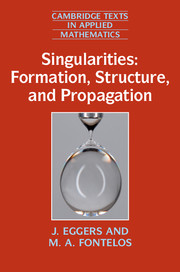Refine search
Actions for selected content:
6993 results in Mathematical modeling and methods
3 - Similarity profile
- from PART I - SETTING THE SCENE
-
- Book:
- Singularities: Formation, Structure, and Propagation
- Published online:
- 05 September 2015
- Print publication:
- 10 September 2015, pp 32-62
-
- Chapter
- Export citation
PART I - SETTING THE SCENE
-
- Book:
- Singularities: Formation, Structure, and Propagation
- Published online:
- 05 September 2015
- Print publication:
- 10 September 2015, pp 1-2
-
- Chapter
- Export citation
15 - Contact lines and cracks
- from PART III - PERSISTENT SINGULARITIES: PROPAGATION
-
- Book:
- Singularities: Formation, Structure, and Propagation
- Published online:
- 05 September 2015
- Print publication:
- 10 September 2015, pp 390-426
-
- Chapter
- Export citation
12 - The dynamical system
- from PART III - PERSISTENT SINGULARITIES: PROPAGATION
-
- Book:
- Singularities: Formation, Structure, and Propagation
- Published online:
- 05 September 2015
- Print publication:
- 10 September 2015, pp 298-312
-
- Chapter
- Export citation
8 - A numerical example: drop pinch-off
- from PART II - FORMATION OF SINGULARITIES
-
- Book:
- Singularities: Formation, Structure, and Propagation
- Published online:
- 05 September 2015
- Print publication:
- 10 September 2015, pp 186-206
-
- Chapter
- Export citation
Appendix B - Index notation and the summation convention
-
- Book:
- Singularities: Formation, Structure, and Propagation
- Published online:
- 05 September 2015
- Print publication:
- 10 September 2015, pp 431-433
-
- Chapter
- Export citation
Preface
-
- Book:
- Singularities: Formation, Structure, and Propagation
- Published online:
- 05 September 2015
- Print publication:
- 10 September 2015, pp xiii-xvi
-
- Chapter
- Export citation
Appendix A - Vector calculus
-
- Book:
- Singularities: Formation, Structure, and Propagation
- Published online:
- 05 September 2015
- Print publication:
- 10 September 2015, pp 427-430
-
- Chapter
- Export citation
7 - Drop breakup
- from PART II - FORMATION OF SINGULARITIES
-
- Book:
- Singularities: Formation, Structure, and Propagation
- Published online:
- 05 September 2015
- Print publication:
- 10 September 2015, pp 143-185
-
- Chapter
- Export citation
PART II - FORMATION OF SINGULARITIES
-
- Book:
- Singularities: Formation, Structure, and Propagation
- Published online:
- 05 September 2015
- Print publication:
- 10 September 2015, pp 141-142
-
- Chapter
- Export citation
1 - What are singularities all about?
- from PART I - SETTING THE SCENE
-
- Book:
- Singularities: Formation, Structure, and Propagation
- Published online:
- 05 September 2015
- Print publication:
- 10 September 2015, pp 3-15
-
- Chapter
-
- You have access
- Export citation
11 - Shock waves
- from PART III - PERSISTENT SINGULARITIES: PROPAGATION
-
- Book:
- Singularities: Formation, Structure, and Propagation
- Published online:
- 05 September 2015
- Print publication:
- 10 September 2015, pp 259-297
-
- Chapter
- Export citation
Dedication
-
- Book:
- Singularities: Formation, Structure, and Propagation
- Published online:
- 05 September 2015
- Print publication:
- 10 September 2015, pp v-vi
-
- Chapter
- Export citation
5 - Local singular expansions
- from PART I - SETTING THE SCENE
-
- Book:
- Singularities: Formation, Structure, and Propagation
- Published online:
- 05 September 2015
- Print publication:
- 10 September 2015, pp 89-114
-
- Chapter
- Export citation
2 - Blowup
- from PART I - SETTING THE SCENE
-
- Book:
- Singularities: Formation, Structure, and Propagation
- Published online:
- 05 September 2015
- Print publication:
- 10 September 2015, pp 16-31
-
- Chapter
- Export citation

Singularities: Formation, Structure, and Propagation
-
- Published online:
- 05 September 2015
- Print publication:
- 10 September 2015
ANALYTICAL REPRESENTATIONS OF REGULAR-SHAPED NANOSTRUCTURES FOR GAS STORAGE APPLICATIONS
-
- Journal:
- The ANZIAM Journal / Volume 57 / Issue 1 / July 2015
- Published online by Cambridge University Press:
- 02 September 2015, pp. 43-61
-
- Article
-
- You have access
- Export citation
MODELLING ION, WATER AND ION–WATER CLUSTER ENTERING PEPTIDE NANOTUBES
- Part of
-
- Journal:
- The ANZIAM Journal / Volume 57 / Issue 1 / July 2015
- Published online by Cambridge University Press:
- 02 September 2015, pp. 62-78
-
- Article
-
- You have access
- Export citation
DESIGN OF A NANOTORI-METALLOFULLERENE LOGIC GATE
- Part of
-
- Journal:
- The ANZIAM Journal / Volume 57 / Issue 1 / July 2015
- Published online by Cambridge University Press:
- 25 August 2015, pp. 29-42
-
- Article
-
- You have access
- Export citation
EFFECTIVE SLIP LENGTH: SOME ANALYTICAL AND NUMERICAL RESULTS
- Part of
-
- Journal:
- The ANZIAM Journal / Volume 57 / Issue 1 / July 2015
- Published online by Cambridge University Press:
- 25 August 2015, pp. 79-88
-
- Article
-
- You have access
- Export citation

